ISSN ONLINE(2319-8753)PRINT(2347-6710)
ISSN ONLINE(2319-8753)PRINT(2347-6710)
Vijay A. Kotkar 1, Sanjay S. Gharde 2
|
| Related article at Pubmed, Scholar Google |
Visit for more related articles at International Journal of Innovative Research in Science, Engineering and Technology
Image enhancement is a processing on an image in order to make it more appropriate for certain applications. It is used to improve the visual effects and the clarity of image or to make the original image more conducive for computer to process. Contrast enhancement changing the pixels intensity of the input image to utilize maximum possible bins. We need to study and review the different image contrast enhancement techniques because contrast losses the brightness in enhancement of image. By considering this fact, the mixture of global and local contrast enhancement techniques may enhance the contrast of image with preserving its brightness. There are many image contrast enhancement techniques such as HE, BBHE, DSIHE, MMBEBHE, RMSHE, MHE. BPDHE, RSWHE, GHE, LHE and LGCS. This paper focuses on the comparative study of contrast enhancement techniques with special reference to local and global enhancement techniques. Also proposed solution is identified to apply to this enhancement technique. This novel method will use in many fields, such as medical image analysis, remote sensing, HDTV, hyper spectral image processing, industrial X-ray image processing, microscopic imaging etc.
Keywords |
| Image enhancement, histogram equalization, contrast enhancement. |
INTRODUCTION |
| Image enhancement process consist of a collection of techniques that seek to improve the visual appearance of an image or to convert the image to a form better suited for analysis by a human or machine. Image enhancement means as the improvement of an image appearance by increasing dominance of some features or by decreasing ambiguity between different regions of the image. The objective of enhancement is to process an image so that the result is more suitable than the original image for a specific application. Image enhancement is one of the most interesting and visually appealing areas of image processing. Image enhancement is broadly divided into two categories: spatial domain methods and frequency domain methods. Spatial domain method refers to the image plane and approaches in this category are based on direct operation of pixels in an image. Frequency domain methods are based on adapting the Fourier transform of an image. Image enhancement, which is one of the significant techniques in digital image processing, plays important roles in many fields, such as medical image analysis, remote sensing, high definition television (HDTV), hyper spectral image processing, industrial X-ray image processing, microscopic imaging etc. Image enhancement is a processing on image in order to make it more appropriate for certain applications. It is mainly utilized to improve the visual effects and the clarity of the image, or to make the original image more conducive for computer to process [1]. Generally, an image may have poor dynamic range or distortion due to the poor quality of the imaging devices or the adverse external conditions at the time of acquisition. The contrast enhancement is one of the commonly used image enhancement methods. Many methods for image contrast enhancement have been proposed which can be broadly categorized into two methods: direct methods and indirect methods. Among the indirect methods, the histogram modification techniques have been widely utilized because of its simplicity and explicitness in which the histogram equalization (HE) is one of the most frequently used techniques. The fundamental principle of HE is to make the histogram of the enhanced image approximate to a uniform distribution so that the dynamic range of the image can be fully exploited. Contrast enhancement changing the pixels intensity of the input image to utilize maximum possible bins. Contrast enhancement is based on five techniques such as local, global, partial, bright and dark contrast. This paper is organized as follows: Section II describes the different contrast enhancement techniques. Section III describes the result and discussion. Section IV describes problem definition. Section V describes our proposed solution. Section VI gives the future work and finally Section VII concludes the paper. |
II. METHODOLOGY |
| Image Contrast Enhancement techniques: |
| A. Histogram Equalization (HE) |
| Histogram equalization is widely used for contrast enhancement in a variety of applications due to its simple function and effectiveness. It works by flattening the histogram and stretching the dynamic range of the gray levels by using the cumulative density function of the image. One problem of the histogram equalization is that the brightness of an image is changed after the histogram equalization, hence not suitable for consumer electronic products, where preserving the original brightness and enhancing contrast are essential to avoid annoying artifacts. |
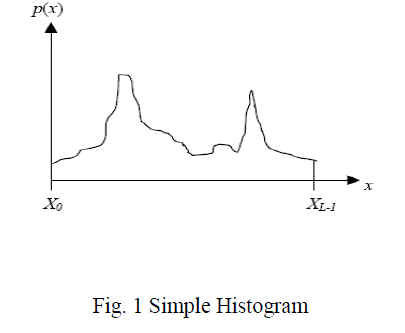 |
| X0 – XL-1 ïÃÆè 0 to 255 Gray levels P(x) ïÃÆè Number of pixels |
| Above Fig. 1 shows the histogram equalization is used to maps the input image into the entire dynamic range, (Xo, XL-1) by using the cumulative density function as a transform function. HE has an effect of stretching the dynamic range of a given histogram since HE flattens the density distribution of the image [15]. |
| B. Brightness Bi-Histogram Equalization (BBHE) |
| In order to overcome the drawback introduced by the HE method described in the previous subsection, a brightness preserving Bi-HE (BBHE) method was proposed. Fig. 2 shows that BBHE method is used to decompose the original image into two sub-images, by using the image mean gray-level, and then apply the HE method on each of the subimages. |
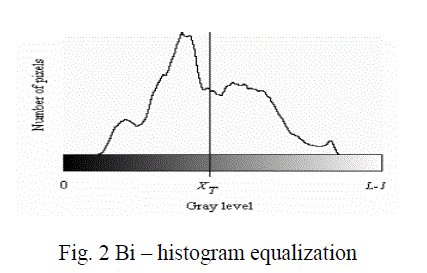 |
| The BBHE method produces an output image with the value of brightness (mean gray-level) located in the middle of the mean of the input image. The BBHE technique is a hybrid method between mean brightness preserving histogram equalization methods with clipped histogram equalization method. This technique can enhance the images without producing unnecessary artifacts [15]. |
| C. Dualistic Sub Image Histogram Equalization (DSIHE) |
| Dualistic sub-image histogram equalization (DSIHE) also separates the input histogram into two subsections. Both BBHE and DSIHE are similar except that DSIHE chooses to separate the histogram based on gray level with cumulative probability density equal to 0.5 instead of the mean as in BBHE, i.e. instead of decomposing the image based on its mean gray level, the DSIHE method decomposes the image aiming at the maximization of the Shannon's entropy of the output image. The aggregation of the original image's gray level probability distribution is decomposed. |
| The result of the dualistic sub-image histogram equalization is obtained after the two equalized sub images are composed into one image [15]. |
| D. Minimum Mean Brightness Error Bi-Histogram Equalization (MMBEBHE) |
| The basic principle of the BBHE and DSIHE methods of decomposing an image and then applying the CHE method to equalize the resulting sub-images independently, proposed the minimum mean brightness error Bi-HE (MMBEBHE) method. The main difference between the BBHE and DSIHE methods and the MMBEBHE one is that the latter searches for a threshold level that decomposes the image into two sub-images, such that the minimum brightness difference between the input image and the output image is achieved, whereas the former methods consider only the input image to perform the decomposition. Once the input image is decomposed by the threshold level, each of the two sub-images has its histogram equalized by the classical HE process, generating the output image. Assumptions and manipulations for finding the threshold level in some time complexity. Such strategy allows us to obtain the brightness of the output image without generating the output image for each candidate threshold level, and its aim is to produce a method suitable for real-time applications [16]. |
| MMBEBHE technique consists of three steps: |
| 1. Calculate the AMBE for each of the threshold level. |
| 2. Find the threshold level, XT that yield minimum MBE. |
| 3. Separate the input histogram into two based on the XT found in step 2 and equalized them independently as in BBHE. |
| E. Recursive Mean Separate Histogram Equalization (RMSHE): |
| In Recursive mean-separate histogram equalization (RMSHE) method, instead of decomposing the image only once, Fig. 3 (a) and (b) shows that Histogram before and after HE or equivalently RMSHE, r=0 and r=1 respectively to perform image decomposition recursively, up to a scale r, generating 2r sub-images. After that, each one of these subimages is independently enhanced using the Histogram Equalization (HE) method. When r = 0 (no sub-images are generated) and r =1, the RMSHE method is equivalent to the HE and BBHE methods, respectively. In this method, the preservation of the output image increases as r (separation level) increases [17]. |
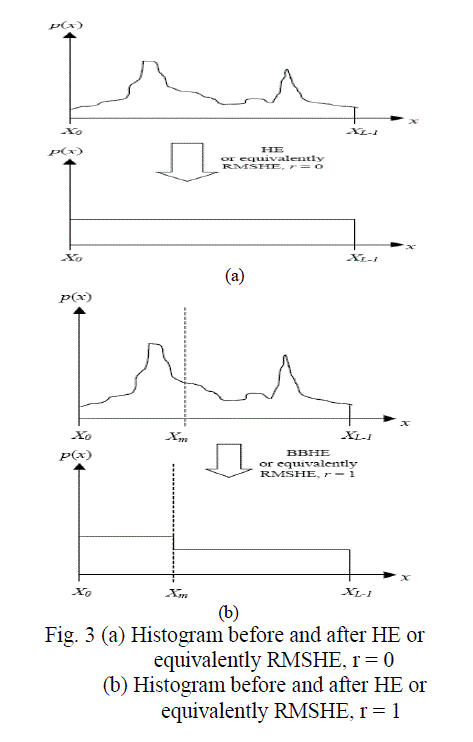 |
| To perform the separation recursively separate each new histogram further based on their respective mean. It is analyzed mathematically that the output image's mean brightness will converge to the input image's mean brightness as the number of recursive mean separation increases. Besides, the recursive nature of RMSHE also allows scalable brightness preservation, which is very useful in consumer electronics. |
| F. Multi Histogram Equalization (MHE) |
| In this technique, decompose the image into several sub-images, such that the image contrast enhancement provided by the HE in each sub image is less intense, leading the output image to have a more natural look. The conception of such methods arises two questions. The first question is how to decompose the input image. As HE is the focus of the work, the image decomposition process is based on the histogram of the image. The histogram is divided into classes, determined by threshold levels, where each histogram class represents a sub-image. The decomposition process can be seen as an image segmentation process executed through multi-threshold selection. The second question is in how many sub-images an image should be decomposed on. This number depends on how the image is decomposed, and so this question is directly linked with the first question [18]. |
| MHE technique consists of three steps: |
| 1. Multi histogram decomposition. |
| 2. Finding the optimal thresholds. |
| 3. Automatic thresholding criterion. |
| G. Brightness Preserving Dynamic Histogram Equalization (BPDHE) |
| In BPDHE method the original image is decomposed into multiple sub images according to their local maxima, then the dynamic histogram equalization is applied to each sub image and finally, the sub Images are combined. It divides the histogram based on the local maxima. It produces the output image with the mean intensity almost equal to the mean intensity of the input, thus fulfils the requirement of maintaining the mean brightness of the image. This method smoothes the input histograms with one dimensional Gaussian filter, and then partitions the smoothed histogram based on its local maxima. After that it assigns new dynamic range to each partition. Then, the histogram equalization process is applied independently to these partitions, based on this new dynamic range and the output image is normalized to the input mean brightness. |
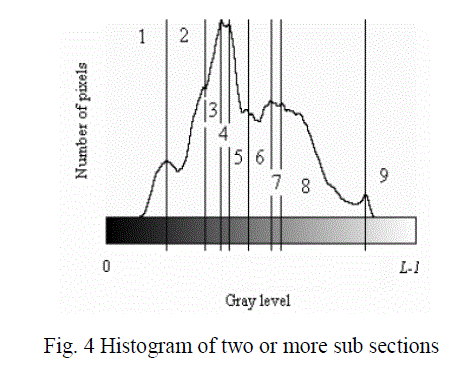 |
| The histogram of the image before enhancement normally does not occupy all the dynamic range of the gray level. Fig. 4 shows that if the histogram is partitioned into more than two sub sections, some of the sections will have a very narrow range. Due to small range, these sections will be not enhanced significantly by histogram equalization [19]. BPDHE technique consists of five steps: |
| 1. Smooth the histogram with Gaussian filter. |
| 2. Detection of the location of local maximums from the smoothed histogram. |
| 3. Map each partition into a new dynamic range. |
| 4. Equalize each partition independently. |
| 5. Normalize the image brightness. |
| H. Recursive Separated and Weighted Histogram Equalization (RSWHE) |
| RSWHE consists of three modules, histogram segmentation, histogram weighting, and histogram equalization. Fig. 5 shows that the histogram segmentation module takes the input image X, computes the input histogram H(X) and recursively divides the input histogram into two or more sub-histograms. The histogram weighting module modifies the sub-histograms by using a normalized power law function. Lastly, the histogram equalization module runs histogram equalization individually over each of the modified sub-histograms. RSWHE technique consists of three modules: |
| 1. Histogram segmentation module: Split the image into two or more histograms recursively based on the mean and median value. |
| 2. Histogram weighting module: Change the sub histogram through weighting process based on normalize law function. |
| 3. Histogram equalization module: Lastly equalize the weighted sub histogram independently. |
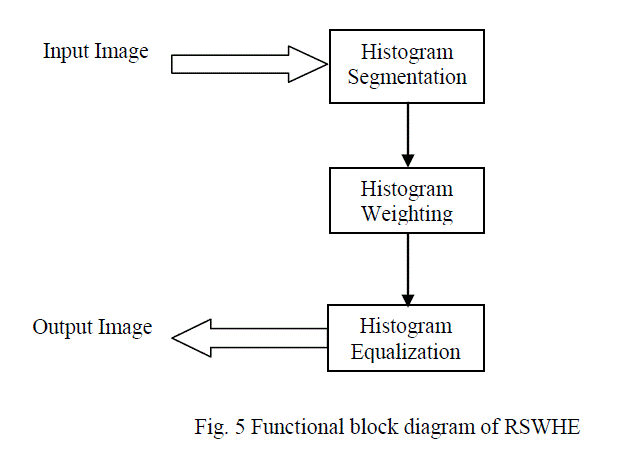 |
| I. Global Transformation Histogram Equalization (GHE) |
| The global transformation function remaps the intensity values of the image in such a way that it stretches the dynamic range of the image histogram, resulting in general contrast enhancement. The Recursive Mean Separate Histogram Equalization (RMSHE) is used as a generalization of both GHE and BBHE that allows scalable brightness preservation. The main idea is to divide the input histogram into two parts based on the mean of the input histogram. After mean partitioning, the resulting sub histogram pieces might be further divided into more sub-histograms based on their respective means depending on the level of recursion r. The resulting 2r histogram regions are equalized independently [14]. Thus, the global transformation function is obtained as: |
 |
| where g denotes the intensity value, gmin and gmax are the lower and upper bound of each histogram partition, h(x) denotes the histogram count for intensity value x, and T(g) is the global transformation function. The level of recursion provides scalability to allow adjustment of the brightness level, based on individual’s preference. |
| J. Local Transformation Histogram Equalization (LHE) |
| GHE takes the global information into account and cannot adapt to local light condition. Local Histogram Equalization (LHE) performs block-overlapped histogram equalization. LHE defines a sub-block and retrieves its histogram information then histogram equalization is useful for the center pixel using the CDF of that sub block. After that, the sub block is moved by one pixel and sub block histogram equalization is repeated until the end of the input image is reached. Though LHE cannot adjust to partial light information, still it over-enhances some portions depending on its mask size. However, selection of an optimal block size that enhances all part of an image is not an easy task to perform. The intensity pair distribution based method exploits the neighborhood information of all pixels to generate a global intensity mapping function. In general, digital images contain a 2D array of intensity values, with locally varying information that results from a different combination of unexpected features such as edges and uniform regions. Since different parts of the image have different statistical characteristics, apply the same approach block wise to handle local information more effectively. Within each block, generate the set of intensity pairs from a pixel’s 8-connected neighbors. Fig. 6 shows the intensity pairs from sample 3 x 3 neighborhood windows [14]. |
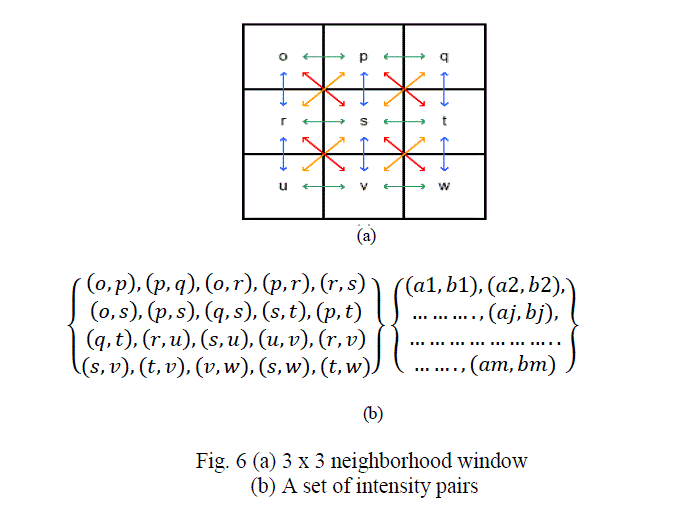 |
| In a real 2D image, many edge-pairs exist near the edges. Therefore, accumulate all the expansion forces between the edge pairs. Now the smooth intensity pairs may lie within the intensity range of the edge pairs. Due to the contrast stretch, the smooth region’s intensity will also be stretched. To avoid such circumstances, opposed to expansion forces are generated within the intensity range of the smooth intensity pairs. Similarly, all the opposed to expansion forces are accumulated for those intensity pairs of the smooth region, and then subtracted from the expansion forces with a certain impact factor w to obtain the net expansion force. The opposed to expansion force ensures the smoothness for homogeneous regions in net-expansion force. |
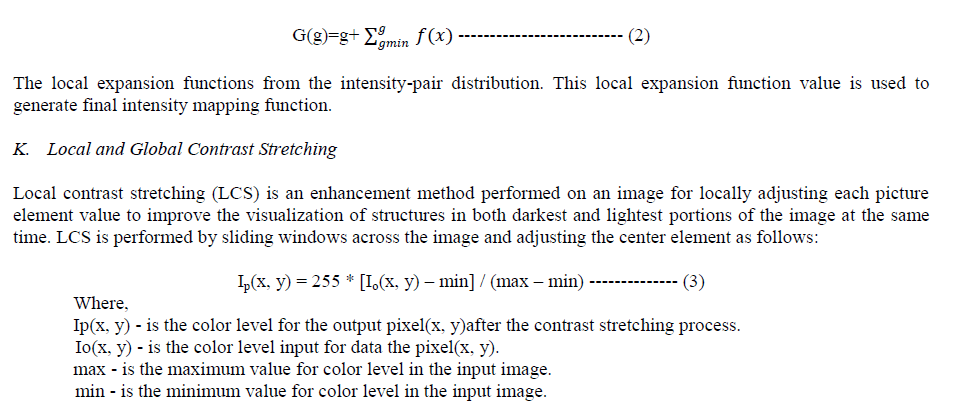 |
| From the formula (x, y) are the coordinates of the center picture element in the KERNEL and min and max are the minimum and maximum values of the image data in the selected KERNEL. Local contrast stretching will consider every range of color palate in the image (R, G and B). The range of every color will be used for contrast stretching process to represent every range of color. This will give every color palate a set of min and max values. Global contrast stretching considers all color palate range now to determine the maximum and minimum for all RGB color image. The mixture of RGB color will give only one value for maximum and minimum for RGB color. Maximum and minimum value will be used for contrast stretching process [20]. |
III. RESULT AND DISCUSSION |
| In Histogram Equalization technique the brightness of the image is changed. Therefore this technique is not suitable for consumer electronics. The BBHE and DSIHE techniques separate the input histogram into two subsections based on mean value and median value respectively. The RMSHE, BPDHE and RSWHE techniques divides histogram into two or more subsections. In RMSHE techniques divides histogram into several subsections based on local mean values. In BPDHE technique divides the histogram into several subsections and equalizes them independently, division is based on local maximums of input histogram. In RSWHE technique divides input histogram into two or more subsections recursively, to modify sub histogram by means of weighting process based on normalized power law function. Global and Local transformation techniques produces the best image contrast enhancement as compare to other contrast enhancement techniques because these techniques produces images without undesirable artifacts and maintains input mean brightness. |
IV. PROBLEM DEFINITION |
| Generally in enhancement of image contrast will lose the brightness, the purpose of this novel method is to enhance contrast with preserving natural visibility of image, sharpening details in more contrasted manner, preserving the overall shape of histogram, stretch histogram corresponding to their bins, utilize more bins by image histogram showing better enhancement of image. |
V. PROPOSED SOLUTION |
| We propose two methods first is Local Feature Enhancement for exploring local features of image. Second one is Bidirectional Smooth Histogram Stretching (BSHS) for global enhancement of image. Fig. 7 shows the block diagram of proposed method. We combine result of both procedures by two ways. One is combining in weighted manner to get Weighted of Local and Bidirectional Smooth Histogram Stretching (WLBSHS) and other one is initially perform local enhancement on original image to get locally enhanced image. After that Perform BSHS on locally enhance image to get Local then Bidirectional Smooth Histogram Stretching (LBSHS). |
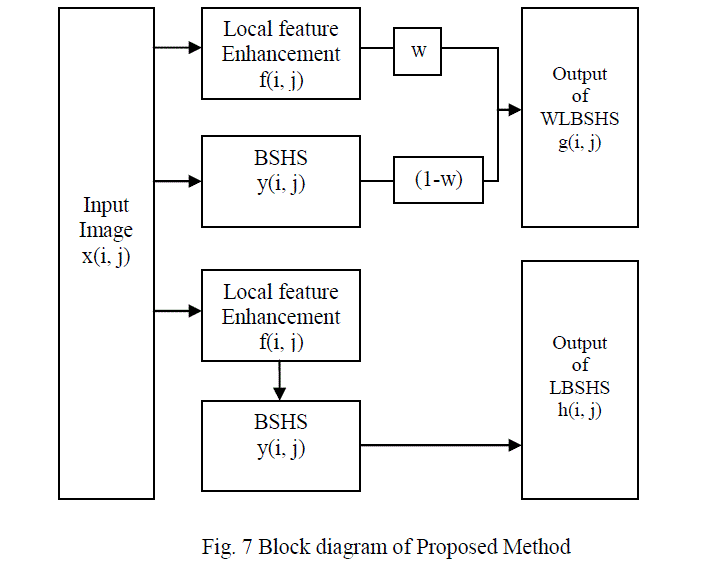 |
| Under local enhancement, we calculate the local feature of image. x(i, j) represents a pixel value of image. f(i, j) denote the enhanced value of x(i, j). w denotes the weighting coefficient. g(i, j) and h(i, j) represents output of WLBSHS and LBSHS methods respectively. |
VI. CONCLUSION |
| Image contrast enhancement plays an important role in image enhancement. In this paper, the different image contrast enhancement techniques are analyzed. The mixture of global and local contrast enhancement techniques is superior than other techniques because these techniques improve the visual effects and clarity of the image with preserving its brightness. This is proposed system, implementation work is going on. The major goal of image contrast enhancement is to produce images without severe side effects at the same time maintain input mean brightness. |
References |
|